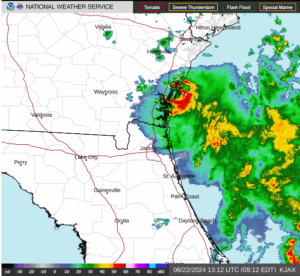Potential Tropical Cyclone Eighteen prompted the governments of Cuba and the Bahamas to issue Tropical Storm Warnings and Watches for portions of those countries on Friday afternoon. At 5:00 p.m. EDT on Friday the center of Potential Tropical Cyclone Eighteen was located at latitude 17.5°N and longitude 84.5°W which put it about 415 miles (670 km) south-southwest of Havana, Cuba. It was moving toward the north-northwest at 6 m.p.h. (10 km/h). The maximum sustained wind speed was 40 m.p.h. (65 km/h) and there were wind gusts to 50 m.p.h. (80 km/h). The minimum surface pressure was 1006 mb.
Tropical Storm Warnings were issued for the Cuban provinces of Isla de la Juventud, La Habana, Ciudad de la Habana, Matanzas, Cienfuegos, and Villa Clara. Tropical Storm Warnings were also issued for the northwestern Bahamas including the Abacos, Andros Island, Berry Island, Bimini, Eleuthera, Grand Bahama Island and New Providence. Tropical Storm Watches were issued for the Central Bahamas including Cat Island, the Exumas, Long Island, Rum Cay and San Salvador.
An Air Force Reserve Hurricane Hunter reconnaissance plane investigated the system formerly known as Invest 93L on Friday afternoon. The plane found sustained winds to tropical storm force. The plane also found a broad circulation center with several smaller centers of circulation revolving around inside the broader center. Based on the observations from the plane, the National Hurricane Center (NHC) chose not to upgrade the system to Tropical Storm Philippe in its 5:00 p.m. EDT advisory. However, NHC did change the designation of the system from Invest 93L to Potential Tropical Cyclone Eighteen. If a more well defined center of circulation develops, then NHC could still change designation of the system to Tropical Storm Philippe.
The circulation of Potential Tropical Cyclone Eighteen is still organizing. As mentioned above, there is a broad center of counterclockwise rotation. There are also several smaller counterclockwise swirls within the broader center. More showers and thunderstorms developed closer to the center of circulation on Friday afternoon. The storms closer to the center of circulation were generating some upper level divergence which was pumping away mass to the northeast of the system. Some bands of showers and thunderstorms were developing in the outer portions of the circulation.
Potential Tropical Cyclone Eighteen will move through an environment somewhat favorable for intensification. It will move over water where the Sea Surface Temperature is near 30°C. The system is embedded in a flow over warm moist air. However there is a stationary front northwest of the system and there is cooler, drier air north of the stationary front. The system is currently under the western side of an upper level ridge. The upper level winds are weak and there is not much vertical wind shear. Potential Tropical Cyclone Eighteen could slowly intensify during the next 24 hours as the circulation becomes more well organized.
The ridge east of Potential Tropical Cyclone Eighteen is steering the system toward the north-northwest. That general motion should continue for another six to twelve hours. An upper level trough will approach the system from the west on Saturday and the trough will start to steer it more toward the northeast. On its anticipated track Potential Tropical Cyclone Eighteen will approach Cuba on Saturday afternoon. The center of the system will move south of the Florida Keys on Saturday night and it could move across the northwestern Bahamas on Sunday.
The system will bring gusty winds and locally heavy rain to those locations. The locally heavy rain could cause flooding. There could be a storm surge of several feet (one to two meters) on parts of the south coast of Cuba, where the wind blows the water toward the coast. There could also be some storm surge along the coasts of the Florida Keys.

